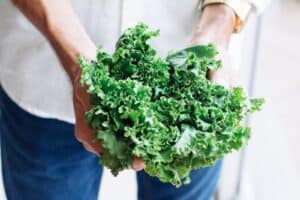Kale has taken the culinary world by storm in recent years, and for good reason. This leafy green powerhouse is not only packed with essential nutrients but also incredibly versatile in the kitchen. Whether you’re a seasoned chef or a cooking novice, there are countless ways to incorporate kale into your meals. In this comprehensive guide, we’ll explore the world of kale, from its nutritional benefits to delicious recipes that will make you fall in love with this hearty green. So, let’s dive into the world of cooking with kale!
The Nutritional Powerhouse
Before we get into the culinary magic of kale, let’s take a moment to appreciate its impressive nutritional profile. Kale is often referred to as a superfood, and for a good reason. It’s loaded with vitamins, minerals, and antioxidants that can benefit your overall health.
Kale’s Nutritional Highlights

- Vitamins Galore: Kale is a rich source of vitamins A, C, and K, essential for various bodily functions.
- Mineral Boost: It provides minerals like calcium, potassium, and magnesium, promoting bone health and proper muscle function.
- Fiber-Rich: Kale is packed with dietary fiber, aiding in digestion and promoting a feeling of fullness.
- Antioxidant Powerhouse: Its high antioxidant content helps combat oxidative stress and inflammation.
Kale Varieties and Selection
To cook with kale effectively, it’s essential to understand the different varieties available and how to select the best bunch for your recipes.
Exploring Kale Varieties
Kale comes in various types, each with its own unique characteristics. Here are some of the most common varieties:
- Curly Kale: This is the most recognizable variety with its ruffled leaves and slightly bitter flavor. It’s great for salads and crisping into kale chips.
- Lacinato Kale (Dinosaur Kale): Lacinato kale has long, dark green, bumpy leaves. It has a milder flavor and is excellent for sautéing and soups.
- Tuscan Kale: Also known as Dino kale or Italian kale, it has dark, flat leaves and a rich flavor. Ideal for adding to pasta dishes and soups.
Selecting Fresh Kale
When choosing kale, look for:
- Bright, vibrant leaves.
- Firm and sturdy stems.
- No wilting or yellowing.
Preparing Kale for Cooking

Properly preparing kale is essential to bring out its best flavors and textures. Here’s how to do it:
Washing and Prepping Kale
- Start by rinsing the kale leaves thoroughly under cold running water.
- Remove the tough stems and ribs by folding the leaves in half lengthwise and cutting along the stem.
- Chop or tear the kale into your desired size, whether it’s ribbons for salads or bite-sized pieces for sautéing.
Cooking Techniques
Now, let’s dive into the exciting part – cooking kale! Kale can be prepared in various ways, each offering a unique taste and texture.
Sautéed Kale
Sautéing kale is a quick and delicious method that preserves its vibrant color and nutrients. Here’s how to do it:
Ingredients:
- Chopped kale leaves
- Olive oil
- Garlic cloves
- Red pepper flakes (for a kick)
- Lemon juice (for a zesty finish)
- Salt and pepper to taste
Instructions:
- Heat olive oil in a large skillet over medium-high heat.
- Add minced garlic and red pepper flakes for extra flavor and kick.
- Add the chopped kale leaves and stir occasionally.
- Sauté until the kale turns tender but maintains its vibrant color.
- Finish with a squeeze of fresh lemon juice and season with salt and pepper to taste.
Creative Ways to Cook Kale

Kale is not only a nutritional powerhouse but also a versatile ingredient that can be prepared in numerous creative ways. Let’s explore some exciting ways to cook kale that will elevate your meals and add a burst of flavor and nutrition.
1. Kale in a Hearty Greens Salad
Cooking Kale: While kale is often enjoyed raw in salads, you can enhance its flavor and texture by lightly sautéing it. Heat a soup pot over medium heat and add a touch of olive oil and bacon fat for a smoky richness. Add thinly sliced kale leaves and stir occasionally until they wilt slightly. Finish with a splash of white wine and a pinch of fresh thyme for extra depth of flavor.
Sweet Squash Addition: For a delightful twist, include sweet squash cubes in your salad. Roast them on a baking sheet until tender and caramelized. Toss the cooked kale and roasted sweet squash together, drizzle with a mixture of olive oil and red wine vinegar, and season with salt and pepper. This combination of sweet and savory will delight your taste buds.
2. Kale in a Parmesan Polenta Side Dish
Adding Kale: Elevate your side dishes by incorporating sautéed kale. Start by cooking kale in a large skillet over medium heat with a drizzle of olive oil. Add minced garlic and fresh thyme for a fragrant touch. Once the kale is tender, fold it into creamy Parmesan polenta for a delightful contrast of textures and flavors.
Prep Time Efficiency: This side dish is not only delicious but also quick to prepare. It’s perfect for busy weeknight dinners, adding a nutritious element to your meal in no time.
3. Kale and Black-Eyed Peas Main Course
Kale Recipes: For a hearty and satisfying main course, consider combining kale with black-eyed peas. In a large soup pot, sauté chopped kale leaves in olive oil until they turn vibrant green. Add cooked black-eyed peas, fresh herbs like thyme, and a dash of red pepper flakes for a hint of spice. Simmer the mixture in a flavorful broth until the kale is tender and the flavors meld together.
Gluten-Free Option: This kale and black-eyed peas dish is naturally gluten-free, making it an excellent choice for those with dietary restrictions. It’s a complete meal that’s both nutritious and delicious.
Flavor Combinations and Seasonings
Kale pairs beautifully with a variety of flavors and seasonings. Here are some suggestions to elevate your kale dishes:
Flavor Pairings for Kale
- Garlic and Lemon: The classic combination of garlic’s savory notes and lemon’s zesty brightness complements kale perfectly.
- Parmesan Cheese: Grated Parmesan cheese adds a rich, umami flavor that balances kale’s bitterness.
- Balsamic Vinegar: A drizzle of balsamic vinegar can enhance the earthy tones of kale.
- Nutmeg: A pinch of freshly grated nutmeg can add warmth and depth to creamy kale dishes.
Kale in Different Cuisines
Kale isn’t confined to one culinary tradition; it can be a versatile addition to various cuisines around the world. Let’s explore how different cultures incorporate kale into their dishes.
Kale Around the World
- Italian: In Italy, kale often makes its way into pasta dishes like “Orecchiette with Kale” or “Kale and White Bean Soup.”
- African: In many African countries, kale is used in hearty stews and sautés, such as “African Kale and Peanut Stew.”
- Asian: In Asian cuisine, kale can be added to stir-fries and noodle dishes for a nutritious twist.
Kale as a Substitute and Addition

One of the fantastic things about kale is its versatility. You can use it as a substitute or addition in various recipes to boost their nutritional value.
Using Kale as a Substitute
- For Spinach: Swap out spinach for kale in dishes like quiches, omelets, and dips.
- In Smoothies: Blend raw kale into your morning smoothie for an extra nutritional punch.
- In Soups: Add chopped kale to your favorite soups and stews for a hearty green boost.
Using Kale as an Addition
- Baked Goods: Incorporate finely chopped kale into muffins, frittatas, or even savory tarts.
- Smoothie Bowls: Top your smoothie bowls with fresh kale leaves for added crunch and nutrients.
- Grain Bowls: Add sautéed kale to grain bowls for a burst of color and flavor.
Final Thoughts: Cooking With Kale
Kale is undoubtedly a star ingredient in the world of cooking. Its nutritional benefits, versatility, and delicious flavor make it a must-have in any kitchen. Whether you’re preparing a kale salad, sautéed kale, or incorporating it into international cuisine, there are endless possibilities to explore. So, why wait? Start experimenting with kale in your kitchen today and enjoy the journey to healthier and tastier meals!
Other suggested articles:

